Exhibit 99.3
B.2 & B.3
15 May 2003
budget
2003
Hon Dr Michael Cullen
MINISTER OF FINANCE
FISCAL STRATEGY REPORT
Fiscal Policy Progress: A Snapshot
Long-term
fiscal
objectives | | The Government’s long-term objectives are to run operating surpluses on average over the economic cycle sufficient to meet the requirements for contributions to the New Zealand Superannuation (NZS) Fund, and ensure consistency with the long-term debt objective (gross sovereign-issued debt below 30% of GDP on average over the economic cycle). |
| | |
Short-term
fiscal policy
approach | | To meet these objectives, our approach to date and looking ahead is to build structural operating surpluses to meet NZS Fund contributions, while meeting capital pressures and managing debt at prudent levels.
In general, the approach does not adjust fiscal policy settings in response to economic fluctuations, thereby allowing for the operation of automatic fiscal stabilisers. |
| | |
Fiscal policy
progress to
date | 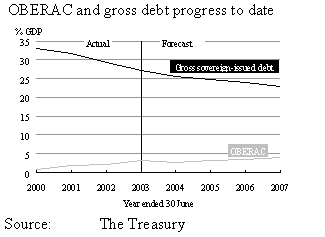
|
| | |
Policy
progress to
date | | Good fiscal performance has supported our policy programme.
Over the past four years, we have created a fairer student loan scheme, restored income-related rents for state housing, reduced waiting times for surgery, restored the 65% wage floor for NZS, implemented a long-term health funding strategy, improved the quality of education, and made significant capital investment in essential infrastructure (including roading, schools and Air New Zealand). |
| | |
Short-term
fiscal
intentions
looking
ahead | | Consistent with our long-term objectives, this Fiscal Strategy Report refreshes our short-term fiscal intentions. This change reflects better than expected progress over the past four years, meaning that there may be scope for further policy changes looking ahead.
If the economic and fiscal outlook evolves as expected, beyond Budget 2003 we will aim to reduce gross sovereign-issued debt to GDP more slowly than current forecasts show. Consistent with this, the OBERAC would remain at around 3% of GDP, and the OBERAC excluding returns on the NZS Fund at around 21/2% of GDP. |
2
Fiscal Strategy Report
Progress to Date
Over the past four years, the Government’s fiscal strategy has focused on building operating surpluses to meet New Zealand Superannuation (NZS) Fund contributions, while meeting capital pressures and managing debt at prudent levels.
The Government’s fiscal policy approach accepts economic fluctuations and allows for the operation of automatic fiscal stabilisers.(1) In general, the Government does not consider it appropriate to adjust fiscal policy settings in response to these fluctuations, thereby allowing automatic stabilisers to play their part in smoothing the temporary fluctuations in the economy.
While following this approach, we continue to deliver on our key policy commitments and we are making substantial progress on our long-term fiscal objectives – better than expected at the beginning of the previous parliamentary term.
Maintaining a strong fiscal position in the future requires us to continue to focus on increasing economic growth and to maintain good fiscal management. This Fiscal Strategy Report (FSR) updates our short-term fiscal intentions to make them clearer in light of progress to date towards our long-term fiscal objectives. It outlines the Government’s progress on our fiscal strategy and confirms that we are on track to continue to meet our objectives over the longer term.
Reviewing the Economic and Fiscal Outlook
The 2003 Budget Policy Statement (BPS) signals a fiscal management approach that focuses on our long-term fiscal objectives, allowing some flexibility in shorter-term Budget decisions. This approach enables us to review our short-term fiscal intentions regularly to ensure that we remain on track towards our long-term objectives.
At the time of the BPS, we laid out our intentions for future Budgets, but said that we would continue to review these as new information on the economic and fiscal outlook becomes available.
The economy has been stronger than was expected at the time of the December Update…
Since the December Economic and Fiscal Update (December Update), the economy has performed better than expected, contributing to higher than expected tax revenue.
The Budget economic forecasts begin from a higher cyclical starting point than the December Update implies, but the Treasury has forecast a more pronounced slowdown in the growth of the real economy over 2003/04.
(1) Automatic fiscal stabilisers are the changes in tax revenue and unemployment spending that occur directly in response to the economic cycle, without any government decision to alter revenue or expenditure. Automatic fiscal stabilisers make the Government’s fiscal position looser in economic downturns, and tighter in economic upturns, thus helping to smooth the economic cycle.
3
Despite this, the nominal economy is forecast to be larger than December Update levels in every year of the forecasts. This is primarily a result of the Budget Economic and Fiscal Update (Budget Update) forecasts building from a higher nominal base. This is due to a combination of macroeconomic results being stronger than expected since the December Update, and some quite large upward revisions to the historical level of nominal GDP – particularly in 2001/02.
As nominal GDP drives tax revenue and the tax-to-GDP ratio remains within a fairly narrow band over the forecast period, tax revenue is also forecast to be higher in every year.
The Budget Update forecasts reflect the balancing of a number of judgements about how the various forces operating on the economy will evolve. Amongst these is the currently weak and uncertain global backdrop, the outbreak of Severe Acute Respiratory Syndrome (SARS) and recent dry weather conditions, which are impacting on farm production and electricity generation.
Many of these factors are acting as negative influences on the short-term outlook, but are expected to diminish later in the year. In fact, we have already seen lower oil prices and a recovery in global equity markets following reduced uncertainty around the situation in Iraq. Furthermore, there are also a range of positive offsetting forces, including strong positive net migration, robust firm balance sheets and the prospect of easier monetary conditions ahead.
… and over the forecast horizon the fiscal position remains positive…
The operating balance dips below the December Update level in the current year, but excluding revaluations and accounting policy changes (OBERAC), it is higher than in the December Update.
From 2003/04 onwards, the OBERAC follows a track similar to the December Update.
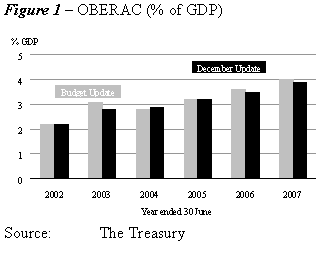
In nominal terms, gross sovereign-issued debt is expected to be broadly similar to that in the December Update.
4
However, as a percentage of GDP it is forecast to be slightly lower than in the December Update due to the projected higher levels of nominal GDP.(2)
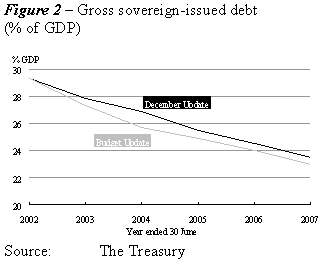
Our Fiscal Policy Decisions Reflect a Balance of Judgements
We need to weigh up judgements about the economic outlook and what this means for the Government’s fiscal position looking forward. As outlined above, this translates into a relatively robust fiscal position that is consistent with meeting our long-term fiscal objectives. This FSR presents an opportunity for the Government to clarify further our short-term fiscal intentions for the 2004, 2005 and 2006 Budgets.
In doing this, we want to ensure that our intentions remain consistent with meeting our long-term fiscal objectives and to recognise progress so far.
The Budget Update forecasts suggest that there may be scope for adjustments to fiscal policy settings beyond 2003/04 without compromising our long-term objectives.
In setting our short-term fiscal intentions, there are a number of factors that we have considered; the main ones are outlined below.
(2) For analysis and explanations, see the Fiscal Outlook chapter of the Budget Update.
5
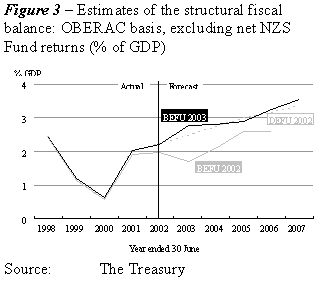
For fiscal policy decision-making, it is important to consider the structural fiscal balance and the direction in which it is heading…
The structural balance adjusts the actual balance for short-term fluctuations in real GDP, and therefore provides a better picture of the underlying fiscal position.
We have made significant progress in increasing the structural fiscal balance. Treasury estimates suggest that its level has been increasing since the year ended June 2000 (although the level can move around with each Update, recent Updates have indicated that actual fiscal surpluses reflect a structural strengthening).
Despite the uncertainty around its current and forecast level, given current assumptions we can expect that it will further increase over the forecast period.(3)
The latest update of the structural balance reflects the impact of recent economic changes (such as higher net migration) on the revenue side. However, there may be some information lags or delayed spending pressures, for example health expenditure, that take longer to affect the expense side. This presents a downside risk to the structural balance.
Overstating structural fiscal positions can lead to governments changing tax and spending plans to an extent which compromises future budget management during subsequent downturns. For example, in the late 1980s, the United Kingdom ran fiscal surpluses but found itself in deficit following the onset of recession. The deterioration was accelerated by discretionary changes to fiscal policies that were initially seen as a prudent adjustment to increased trend growth – yet that view of trend growth later proved over-optimistic and fiscal policy had to be tightened as deficits increased.
(3) Some of the uncertainty around estimates of the structural fiscal balance results from the estimation of trend growth. The December Update discusses some of the relevant issues. Details of the Treasury approach to estimating the structural fiscal balance are described in Treasury Working Papers 01/10 and 02/30.
6
… and to maintain a longer-term perspective
Under the economic and fiscal assumptions used in the 10-year fiscal projections of this FSR, the Government is on track to meet its long-term fiscal objectives, as Figures 4 and 5 illustrate.

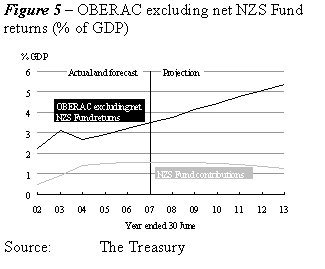
Over longer time horizons (beyond 10-years), as demographic changes impact on, for example, social and health services, satisfying current objectives may require changes to fiscal policy.
Our policy objective is to put in place arrangements to enable the Crown’s finances to cope with this demographic change. This is the idea behind the establishment of the NZS Fund.
It is important to remember that the NZS Fund is by no means a complete solution to the fiscal pressures implied by the projected demographic change. We need to continue to make prudent choices now to avoid adding to the burden on future generations.
Running fiscal surpluses for further pre-funding beyond the NZS Fund also needs to be assessed against the Government’s other social and economic objectives, including policies to increase New Zealand’s sustainable economic growth rate.
7
Short-Term Fiscal Intentions
Revised short-term intentions reflect progress to date and the outlook ahead…
The Budget Update shows rising operating surpluses over the forecast horizon that are in excess of what is required to keep gross debt below 30% of GDP while meeting NZS Fund contributions. The current strength of the Government’s fiscal position enables us to move to full funding of NZS Fund contributions in 2003/04, a year earlier than anticipated. This constitutes an additional contribution of around $80 million.
If the economic outlook evolves as expected in the central forecasts, there may be scope to make some relatively small adjustments to our fiscal policy settings over the next few years, while still maintaining consistency with our long-term objectives. We are making some revisions to our short-term fiscal intentions that reflect the possible nature of these fiscal adjustments.
… but remain firmly in tune with the Government’s long-term objectives…
The 2003 Budget sets out detailed plans for 2003/04. Beyond this, we intend to make fiscal policy decisions consistent with progress on our long-term fiscal objectives. If the economic outlook evolves as currently expected, this suggests that:
• beyond 2003/04, gross sovereign-issued debt would still reduce as a percentage of GDP, but more gradually than the current forecasts show. Our aim is to keep debt below 30% of GDP, with a bias towards reducing rather than raising debt. Consequently there will be a tendency for gross debt-to-GDP to trend downwards over the forecast period
• consistent with this, the OBERAC would remain at around 3% of GDP per annum over the period 2004/05 to 2006/07. As the OBERAC will be influenced increasingly over time by returns on the NZS Fund, which the Fund will retain, the Government will be effectively targeting operating surpluses excluding NZS Fund returns. Over the forecast period beyond 2003/04, consistent with our desired debt trend, we would see the OBERAC excluding NZS Fund returns, absent from cyclical influences, at around 2.5% of GDP.
The exact level of the OBERAC would depend on the mix of operating and capital initiatives. For example, capital initiatives tend to be one-off in nature, whilst operating initiatives have an ongoing operating impact. Running surpluses around this size retains a buffer against adverse economic shocks and is sufficient to meet NZS Fund contributions when they start to plateau as Fund assets build up.
On the basis of current forecasts, surpluses around this level would allow for additional policy changes of under ½% of GDP in each of the 2004, 2005 and 2006 Budgets. This additional flexibility is useful but still relatively small. To illustrate this point, demand-driven forecast changes in this Budget totalled around 0.3% of GDP per annum. Also, the tax and spending package that was announced at the time of the 1996 Budget Update was expected to amount to around 1.5% of GDP per annum.
Any future changes, be they increased spending or changes to tax policies, will reflect our highest policy priorities. At this stage, we see scope for improvements in the level of family assistance to low- to middle-income families and in the incentives to move from benefits into employment.
Annex 2 provides further details of our short-term fiscal intentions.
8
… and remain subject to judgements about a range of relevant factors…
As outlined above, a range of factors are relevant to judgements about the timing and magnitude of such adjustments, including budget pressures and the short- to medium-term economic and fiscal outlook. The Government is continually facing bottom-up spending pressures from a number of sources. To enable the modest policy adjustments discussed above, the Government will need to meet the cost of existing programmes from currently agreed spending plans.
Developments in the economy over the next year will provide further information on some of the important judgements in the Budget Update forecasts, especially the link between recent economic developments and tax revenue, as well as how the economy is tracking. Given the magnitude of the changes contemplated, and the current medium-term economic outlook, we would not expect these adjustments to fiscal plans to place undue pressure on the operation of monetary policy or the current account deficit. We will reassess this judgement at the time we are making decisions.
It is the nature of the environment in which we operate that we are always getting new information on the economy and the fiscal position. How the economy rebounds from the current slowdown will also inform us on the robustness of the fiscal outlook, and is a key reason for the incremental approach upon which we are embarking.
… which we will continue to review again in December and beyond
Our approach remains biased towards caution and incremental changes that characterise prudent fiscal management.
At this point, we have not changed our forecast new operating and capital amounts for future Budgets. Stronger tax returns help absorb the higher than forecast cost of the 2003 Budget package. We will also rephase capital spending amounts over the forecast period to reflect better the timing of known pressures.
By the time of the 2004 BPS the Government will have more economic and fiscal information for decisions surrounding the 2004 Budget. Following the 2004 BPS we will continue to reassess the medium-term outlook and be prepared to make policy changes in subsequent Budgets. For now, we are signalling the direction in which we see fiscal aggregates heading and being clear that we will ensure that future policy changes are consistent with progress towards our long-term fiscal objectives.
Hon Dr Michael Cullen
Minister of Finance
7 May 2003
9
Annex 1
The Government’s Long-term Fiscal Objectives
This annex, when taken together with the main text of this document, meets the disclosure requirements of the Fiscal Responsibility Act 1994 (FRA) with respect to:
• the Government’s long-term fiscal objectives, which are unchanged from the 2003 BPS (Table A1.1 below)
• progress towards these objectives (Table A1.2 below).
Table A1.1 – Long-term fiscal objectives
Long-term fiscal objectives:
Operating balance:
Operating surplus on average over the economic cycle sufficient to meet the requirements for contributions to the NZS Fund and ensure consistency with the long-term debt objective.
Revenue:
Ensure sufficient revenue to meet the operating balance objective.
Expenses:
Ensure expenses are consistent with the operating balance objective.
Net worth:
Increase net worth consistent with the operating balance objective.
Debt:
Manage total debt at prudent levels. In the longer term, gross sovereign-issued debt below 30% of GDP on average over the economic cycle.(5)
To achieve the objectives, the Government’s high-level focus is on:
• Rising surpluses(4) (measured by the OBERAC) during the transition and build-up phase of the NZS Fund, with a focus on core Crown revenue and expenses, including:
• tax-to-GDP around current levels
• core Crown expenses (plus the net payment/withdrawal to the NZS Fund) averaging around 35% of GDP over the horizon used to calculate NZS Fund contributions.
• A robust, broad-based tax system that raises revenue in a fair and efficient way.
• State-owned enterprises (SOEs) and Crown entities contributing to surpluses consistent with their enabling legislation and Government policy.
• Focus on building the NZS Fund assets rather than reducing debt. Increasing net worth consistent with the operating balance objective will see net worth above 30% of GDP by 2011.
• Consistent with the net worth objective, there will also be a focus on quality investment.
• SOEs will have debt structures that reflect best commercial practice. Changes in the level of debt will reflect specific circumstances.
• Net debt will be at levels that are consistent with the gross debt objective and the Government policy of holding financial assets. Net debt, including NZS Fund assets, is expected to fall below 0% of GDP by the end of the decade.
(4) The surplus includes the net (after tax) return on the NZS Fund, which the NZS Fund will retain. Effectively the Government is targeting operating surpluses excluding the NZS Fund’s retained investment returns.
(5) Sovereign-issued debt is debt issued by the New Zealand Debt Management Office (NZDMO) and the Reserve Bank. It excludes debt issued by SOEs and Crown entities and the sovereign-guaranteed debt of SOEs and Crown entities. Gross sovereign-issued debt includes any New Zealand government stock held by the NZS Fund, Government Superannuation Fund, Earthquake Commission, and Accident Compensation Corporation.
10
Table A1.2 – Forecasts of long-term fiscal objectives and indicators (% GDP)
Year end June | | 2000
Actual | | 2001 | | 2002 | | 2003
Forecast | | 2004 | | 2005 | | 2006 | | 2007 | |
Financial Performance | | | | | | | | | | | | | | | | | |
Total Crown revenue | | 39.0 | | 40.1 | | 41.4 | | 43.5 | | 43.9 | | 43.7 | | 43.6 | | 43.5 | |
Core Crown revenue | | 32.0 | | 32.7 | | 32.3 | | 33.2 | | 33.2 | | 32.9 | | 33.0 | | 33.1 | |
Total Crown expenses | | 37.6 | | 39.0 | | 39.5 | | 42.4 | | 41.1 | | 40.5 | | 40.1 | | 39.5 | |
Core Crown expenses | | 31.7 | | 31.5 | | 30.7 | | 32.1 | | 31.1 | | 30.7 | | 30.4 | | 30.1 | |
Operating balance | | 1.4 | | 1.2 | | 1.9 | | 1.1 | | 2.8 | | 3.2 | | 3.6 | | 4.0 | |
OBERAC | | 0.8 | | 1.8 | | 2.2 | | 3.1 | | 2.8 | | 3.2 | | 3.6 | | 4.0 | |
| | | | | | | | | | | | | | | | | |
Core Crown operating | | | | | | | | | | | | | | | | | |
expenses + contributions to NZS Fund | | 31.7 | | 31.5 | | 31.2 | | 33.1 | | 32.5 | | 32.2 | | 32.0 | | 31.6 | |
OBERAC ex Fund returns | | 0.8 | | 1.8 | | 2.2 | | 3.1 | | 2.7 | | 2.9 | | 3.2 | | 3.5 | |
| | | | | | | | | | | | | | | | | |
Financial Position | | | | | | | | | | | | | | | | | |
Net worth | | 7.9 | | 9.9 | | 15.1 | | 15.7 | | 17.9 | | 20.2 | | 22.8 | | 25.8 | |
Total Crown debt | | 31.8 | | 29.8 | | 29.7 | | 29.5 | | 27.3 | | 26.4 | | 25.1 | | 23.2 | |
Gross sovereign-issued debt | | 33.0 | | 31.6 | | 29.3 | | 27.3 | | 25.7 | | 24.9 | | 24.0 | | 23.0 | |
Net (core) Crown debt | | 17.6 | | 14.6 | | 14.4 | | 14.0 | | 13.8 | | 13.0 | | 12.0 | | 10.7 | |
Net debt with NZS | | | | | | | | | | | | | | | | | |
Fund assets | | 17.6 | | 14.6 | | 13.9 | | 12.5 | | 10.8 | | 8.5 | | 5.8 | | 2.7 | |
| | | | | | | | | | | | | | | | | |
NZS Fund | | | | | | | | | | | | | | | | | |
Contributions | | — | | — | | 0.5 | | 0.9 | | 1.4 | | 1.5 | | 1.6 | | 1.6 | |
NZS Fund returns (after tax) | | — | | — | | — | | 0.1 | | 0.1 | | 0.2 | | 0.4 | | 0.5 | |
Accumulated assets | | — | | — | | 0.5 | | 1.5 | | 2.9 | | 4.5 | | 6.2 | | 8.0 | |
11
Annex 2
The Government’s Short-term Fiscal Intentions
This annex, when taken together with the main text of this document, meets the disclosure requirements of the FRA with respect to:
• the Government’s short-term fiscal intentions
• the consistency of these intentions with, and any changes from, the intentions reported in the 2003 BPS
• the consistency of these intentions, and any changes from, the principles of responsible fiscal management in the FRA.
The Government’s fiscal intentions indicate that the Government’s short-term plans are consistent with progress towards our long-term objectives, and therefore with principles of fiscal management.
Table A2.1 – Short-term fiscal intentions
Long-term fiscal
objectives | | 2003 Fiscal Strategy Report:
Short-term fiscal intentions | | 2003 Budget Policy Statement:
Short-term fiscal intentions |
| | | | |
Operating balance: Operating surplus on average over the economic cycle sufficient to meet the requirements for contributions to the NZS Fund and ensure consistency with the long-term debt objective. | | Based on new operating amounts for the 2003 Budget, and indicative amounts for the next two Budgets, the operating balance is forecast to be 3.6% of GDP in 2005/06.
If the economic and fiscal outlook evolves as expected, the Government will make changes to its expense and revenue plans. Operating surpluses (on an OBERAC basis) will be lower than current forecasts, at around 3% of GDP, and operating surpluses excluding returns on the NZS Fund (on an OBERAC basis) would be around 2½% of GDP, remaining consistent with the long-term objective for the operating balance. | | On current forecasts, operating balances will be:
• $2.4 billion in 2001/02 • $2.5 billion in 2002/03 • $3.8 billion in 2003/04 • $4.5 billion in 2004/05 • $5.2 billion in 2005/06 • $5.9 billion in 2006/07 In 2005/06 the operating balance is forecast to be 3.5% of GDP. |
| | | | |
Debt: Manage total debt at prudent levels. In the longer term, gross sovereign-issued debt below 30% of GDP on average over the economic cycle.(6) | | Gross sovereign-issued debt is forecast to be 24% of GDP in 2005/06. In 2005/06 total Crown gross debt is forecast to be 25.1% of GDP.
The Government will set forecast new capital spending amounts that ensure progress is made toward the long-term objective for debt. The Government’s bias is towards lowering rather than raising debt-to-GDP, so there will be a tendency for the ratio to trend downwards over time. | | On current forecasts, gross sovereign-issued debt will be:
• $36.2 billion in 2001/02 • $35.5 billion in 2002/03 • $35.9 billion in 2003/04 • $35.9 billion in 2004/05 • $36.1 billion in 2005/06 • $36.2 billion in 2006/07
In 2005/06 gross sovereign-issued debt will be 24.5% of GDP. |
(6) Sovereign-issued debt is debt issued by the NZDMO and the Reserve Bank; it excludes debt issued by SOEs and Crown entities and the sovereign-guaranteed debt of SOEs and Crown entities. Gross sovereign-issued debt includes any New Zealand government stock held by the NZS Fund, Government Superannuation Fund, Earthquake Commission, and Accident Compensation Corporation.
12
Long-term fiscal
objectives | | 2003 Fiscal Strategy Report:
Short-term fiscal intentions | | 2003 Budget Policy Statement:
Short-term fiscal intentions |
| | | | |
Expenses: Ensure expenses are consistent with the operating balance objective. | | In 2005/06 total Crown expenses are forecast to be 40.1% of GDP. Within this, core Crown expenses are forecast to be 30.4% of GDP. NZS Fund contributions are forecast to be 1.6% of GDP in 2005/06.
Based on new operating expense amounts for the 2003 Budget, and indicative amounts for the next two Budgets, total Crown expenses are forecast to be $59.2 billion in 2005/06, and core Crown expenses are forecast to be $45.0 billion in 2005/06.
The Government will set forecast new expense amounts that ensure progress is made towards the expense objective. | | On current forecasts, total Crown operating expenses will be:
• $48.8 billion in 2001/02 • $53.0 billion in 2002/03 • $54.2 billion in 2003/04 • $56.5 billion in 2004/05 • $58.6 billion in 2005/06 • $60.5 billion in 2006/07
In 2005/06 expenses will be 39.8% of GDP, and NZS Fund contributions will be 1.6%. |
| | | | |
Revenue: Ensure sufficient revenue to meet the operating balance objective. | | Total Crown revenues are forecast to be 43.6% of GDP in 2005/06.Within this, core Crown revenues are forecast to be 33.0% of GDP in 2005/06.
The Government will set revenue plans that ensure progress is made towards the long-term revenue objective. | | On current forecasts, total Crown operating revenues will be:
• $51.2 billion in 2001/02 • $55.5 billion in 2002/03 • $58.0 billion in 2003/04 • $61.0 billion in 2004/05 • $63.8 billion in 2005/06 • $66.4 billion in 2006/07
Total Crown revenues are forecast to be 43.3% of GDP in 2005/06. |
| | | | |
Net worth: Increase net worth consistent with the operating balance objective. | | Net worth is forecast to be 22.8% of GDP in 2005/06, including NZS Fund assets of 6.2% of GDP in 2005/06. | | On current forecasts, net worth will be:
• $18.7 billion in 2001/02 • $21.2 billion in 2002/03 • $25.1 billion in 2003/04 • $29.6 billion in 2004/05 • $34.8 billion in 2005/06 • $40.7 billion in 2006/07
Net worth is forecast to be 23.6% of GDP, including NZS Fund assets of 6.2% of GDP in 2005/06. |
13
Annex 3
Progress Outlooks, Fiscal Forecasts and Consistency with the 2003 BPS
This annex, when taken together with the main text of this document, meets the disclosure requirements of the FRA with respect to:
• 10-year progress outlooks
• the extent to which the fiscal forecasts in the Budget Update are consistent with the short-term fiscal intentions given in the 2003 BPS, and the reasons for any departures from those intentions.
Progress outlooks
Ten-year progress outlooks for revenue, expense and net worth objectives are shown below. Operating balance and gross sovereign-issued debt outlooks are included in the text of the FSR and also in Annex 4.
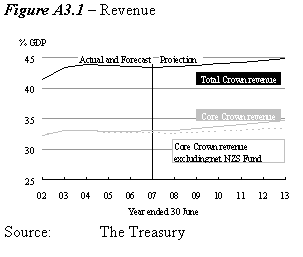
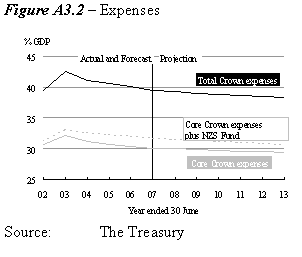
14
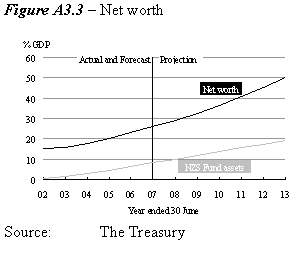
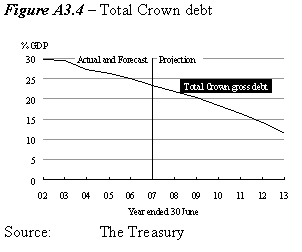
Fiscal forecasts
The differences between the fiscal forecasts in the Budget Update and the short-term fiscal intentions given in the BPS are shown in Table A3.1 below.
Table A3.1 – Changes in fiscal forecasts since the 2003 BPS (June years)
Change | | 2002/03 | | 2003/04 | | 2004/05 | | 2005/06 | | 2006/07 | |
$ million | | | | | | | | | | | |
Total Crown revenue | | 386 | | 756 | | 654 | | 774 | | 959 | |
Total Crown expenses | | 1,530 | | 832 | | 696 | | 666 | | 703 | |
Operating balance | | (1,144 | ) | (76 | ) | (42 | ) | 108 | | 256 | |
| | | | | | | | | | | |
Gross sovereign-issued debt | | (507 | ) | (1,464 | ) | (794 | ) | (554 | ) | (637 | ) |
Net (core) Crown debt | | (660 | ) | (623 | ) | (268 | ) | (32 | ) | (224 | ) |
Net worth | | (1,034 | ) | (1,110 | ) | (1,152 | ) | (1,044 | ) | (788 | ) |
| | | | | | | | | | | |
% GDP | | | | | | | | | | | |
Total Crown revenue | | 0.1 | % | 0.5 | % | 0.3 | % | 0.3 | % | 0.3 | % |
Total Crown expenses | | 0.9 | % | 0.5 | % | 0.3 | % | 0.3 | % | 0.2 | % |
Operating balance | | (0.9 | )% | (0.1 | )% | 0.0 | % | 0.1 | % | 0.1 | % |
| | | | | | | | | | | |
Gross sovereign-issued debt | | (0.5 | )% | (1.2 | )% | (0.6 | )% | (0.5 | )% | (0.5 | )% |
Net (core) Crown debt | | (0.6 | )% | (0.5 | )% | (0.3 | )% | (0.1 | )% | (0.3 | )% |
Net worth | | (0.9 | )% | (0.9 | )% | (0.9 | )% | (0.8 | )% | (0.6 | )% |
15
Source: The Treasury
The differences in nominal terms and as a percentage of GDP reflect changes in the economic and fiscal forecasts. The specific changes to the fiscal aggregates in nominal terms, as compared with those in the 2003 BPS, include:
• operating revenues – are higher in all years. This change is driven by higher tax revenue and increasing Crown entity revenue (tertiary and housing sectors)
• operating expenses – are also higher in all years. This is a result of growth in tertiary student numbers, demographic impacts, and the impact of 2003 Budget spending
• operating balance – is significantly lower in 2002/03 due to revaluations of the Government Superannuation Fund unfunded liability, ACC outstanding claims liability and other devaluations in investments
• gross debt – gross sovereign-issued debt and foreign currency marketable securities and deposits have both reduced in value due to the appreciation of the New Zealand dollar since the December Update. This reduces both debt and financial assets by around $600 million over the forecast horizon. The improved cash position from 2001/02 and delays in capital programmes and refinancing of Crown entity debt also contribute to gross sovereign-issued debt being lower than the December Update in 2003/04. This reverses as capital spending is “caught up” in later years, so that gross sovereign-issued debt is at similar levels to the December Update by 2006/07 (excluding the impact from a rising NZ dollar)
• net debt – follows the same trend as gross debt, being lower than the December Update in 2003/04 before reversing to be at similar levels by 2006/07
• net worth – reflects the operating balance profile.
These changes are explained in more detail in the Fiscal Outlook chapter of the Budget Update.
16
Annex 4
Assumptions Used in the Forecasts and Projections
The assumptions used in producing the four-year forecasts, and the projections beyond these, are summarised here. Explanations for any significant differences from previous projections are also given, as required under the FRA. The projections, which are beyond 2006/07, are based on long-run technical and policy assumptions, not forecasts.
Economic and demographic assumptions
From 2003/04 to 2006/07, all projections incorporate the economic and fiscal forecasts detailed in the Budget Update. The following assumptions apply beyond 2006/07:
• Nominal GDP grows with labour productivity growth (average annual rate of 1.5%), projected changes in the labour force and inflation (annual rate of 2%).
• Demographic and labour force trends are based on Statistics New Zealand population projections with medium fertility, medium mortality and long-term net migration of 5,000 a year. These projections use the 2001 Census as a base.
As a result, the projections beyond 2006/07 are not forecasts, but the result of bottom-up assumptions about the long-run economic drivers of growth. For example, a stronger labour productivity growth assumption will, keeping other factors constant, lead to a higher projection of real GDP growth.
Table A4.1 – Summary of economic assumptions*
| | 2004 | | 2005 | | 2006 | | 2007 | | 2008 | | 2009 | | 2010 | | 2011 | | 2012 | | 2013 | |
June Year(7) | | Forecasts | | Projections | |
| | | | | |
Labour productivity growth | | 1.1 | | 2.1 | | 1.0 | | 1.5 | | 1.5 | | 1.5 | | 1.5 | | 1.5 | | 1.5 | | 1.5 | |
| | | | | | | | | | | | | | | | | | | | | |
Labour force growth | | 1.5 | | 1.4 | | 1.6 | | 1.2 | | 1.0 | | 0.9 | | 0.8 | | 0.7 | | 0.5 | | 0.5 | |
| | | | | | | | | | | | | | | | | | | | | |
Unemployment rate | | 5.5 | | 5.6 | | 5.3 | | 5.2 | | 5.2 | | 5.2 | | 5.2 | | 5.2 | | 5.2 | | 5.2 | |
| | | | | | | | | | | | | | | | | | | | | |
Employment growth | | 1.1 | | 1.3 | | 1.9 | | 1.4 | | 1.0 | | 0.9 | | 0.8 | | 0.7 | | 0.5 | | 0.5 | |
| | | | | | | | | | | | | | | | | | | | | |
Real GDP | | 2.1 | | 3.5 | | 2.8 | | 2.8 | | 2.5 | | 2.4 | | 2.3 | | 2.2 | | 2.1 | | 2.0 | |
| | | | | | | | | | | | | | | | | | | | | |
Consumer price index
(annual % change) | | 1.6 | | 2.1 | | 2.2 | | 2.0 | | 2.0 | | 2.0 | | 2.0 | | 2.0 | | 2.0 | | 2.0 | |
| | | | | | | | | | | | | | | | | | | | | |
Government 10-year bonds
(quarterly average %) | | 6.2 | | 6.2 | | 6.2 | | 6.2 | | 6.2 | | 6.2 | | 6.2 | | 6.2 | | 6.2 | | 6.2 | |
| | | | | | | | | | | | | | | | | | | | | |
Nominal average hourly wage growth | | 3.5 | | 3.3 | | 3.2 | | 3.5 | | 3.5 | | 3.5 | | 3.5 | | 3.5 | | 3.5 | | 3.5 | |
* Annual average % change unless otherwise stated
Sources: The Treasury, Statistics New Zealand
(7) Note that the economic forecasts in the Budget Update are based on a March year.
17
Fiscal assumptions beyond 2006/07
Fiscal policy assumptions in the projections are an extension of current policy settings (for example, no change in tax brackets, CPI indexing of benefits only).
Table A4.2 – Summary of fiscal assumptions
| | Beyond 2006/07 |
| | |
Tax revenue | | GDP linked, with assumptions of constant tax rate boundaries and growth in taxes from individuals of 1.25% per 1% rise in GDP. |
| | |
NZS | | Demographically adjusted and linked to nominal wages after reaching 65% wage floor. |
| | |
Other benefits | | Demographically adjusted and linked to inflation. |
| | |
Health and education | | Demographically adjusted. |
| | |
Finance costs | | A function of debt levels and interest rates. |
| | |
Other | | Not demographically adjusted. |
| | |
Operating allowance | | $1.2 billion (GST inclusive) in 2007/08, increasing with CPI and productivity. |
| | |
Capital allowance | | $550 million in 2007/08, increasing with CPI and productivity. |
| | |
NZS Fund | | Contributions to the proposed Fund are assumed to be consistent with the New Zealand Superannuation Fund Act 2001.(8) Returns are assumed at 8.7% per annum (6.96% per annum after tax). |
Source: The Treasury
Further details of the modelling approach can be found in Treasury Working Paper 00/02 Manual for the Long-term Fiscal Model, available at www.treasury.govt.nz.
Consistency of projections with those in the 2002 FSR
The fiscal projections show that the Government is on track to meet its long-term fiscal objectives. This is reflected in the fact that the 10-year gross sovereign-issued debt track is stronger than it was at the time of the 2002 FSR. This improvement is chiefly due to a stronger forecast base from which the projections are driven.
The projections are also changed by an update to the demographic projections, changes to the way in which the labour force is projected and a reduction in the assumed long-run unemployment rate.
The introduction of updated Statistics New Zealand demographic projections, from a 1999 base to a 2001 Census base, pushes up debt slightly (less than a percentage point of GDP by 2012/13).
Changes to the labour force projections have been made to bring them more into line with the approach used in the four-year forecasts. This impacts positively on GDP projections,
(8) A more detailed review of the assumptions involved in projecting the NZS Fund contributions and earnings can be found on pages 56 and 57 of the 2002 December Economic and Fiscal Update. Further details can be found in Financing New Zealand Superannuation, a Treasury Working Paper by McCulloch and Frances, available at www.treasury.govt.nz.
18
and hence reduces the gross sovereign-issued debt-to-GDP ratio by around 0.5 percentage points of GDP by 2012/13.
Finally, the assumed long-run unemployment rate was reduced to 5.2% from 5.5%, to reflect the value reached at the end of the forecast period. This change also increases GDP projections, and so further reduces debt by just under one percentage point of GDP by 2012/13.
The combination of the stronger forecast base and the changes to projection assumptions results in gross sovereign-issued debt being around seven percentage points of GDP lower in 2012/13 than it would have been under the base and assumptions used in the 2002 FSR.
The fiscal projections include a fiscal drag elasticity assumption of 1.25%. This means that, in the projected years from 2007/08 onwards, tax revenue from individuals is assumed to grow by 1.25% for every percentage point of growth in nominal GDP.
Two factors are chiefly responsible for this, namely:
• the movement of individuals into higher tax brackets over time
• the fact that anyone whose annual taxable income is above the lowest tax bracket pays proportionally more tax on every extra dollar they earn.
Fiscal drag is difficult to measure accurately in history, and may also change over time with adjustments to tax rates and brackets, policy changes and labour market composition. For these reasons and others, the fiscal drag assumption in the projections may overstate the growth of tax revenue from 2007/08 onwards. The fiscal drag assumption will be reviewed for future projections.
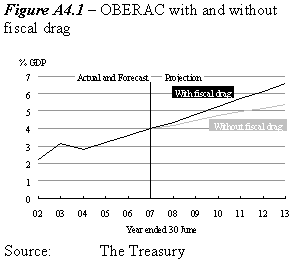
19
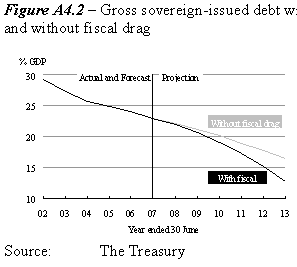
20











